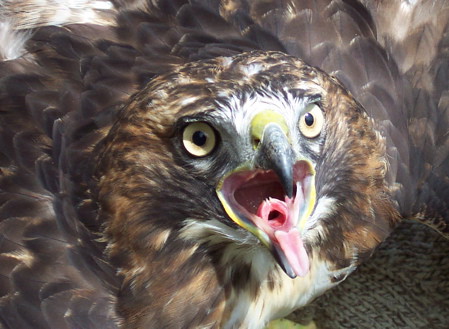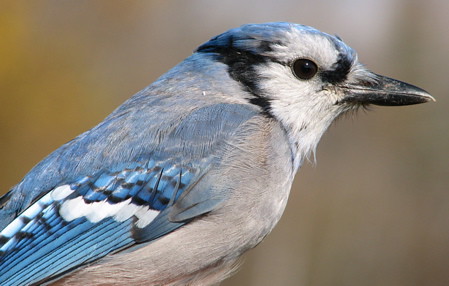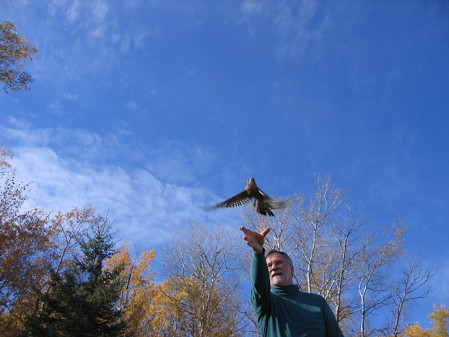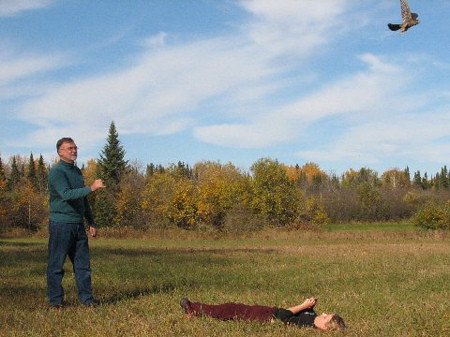Sometimes, it's fun to live in our neighborhood. Oh sure, there are noisy neighbors, but there are benefits. Twice in the last week I have seen Sir Ian McKellen, once behind me line at the grocery store and tonight on our way to the movie theater (he's in town performing King Lear at the Guthrie). I didn't say anything at the grocery store, but tonight when I pointed him out to Non Birding Bill, he went over, greeted him and told him how much he enjoyed his work as an actor. He was really, really nice and very gracious. Can I say how much I enjoy just picking him out in the streets among all the other people? It's like finding a Ross's goose mixed in with a bunch of snow geese.
On to hawk banding!
Here's the man who makes my weekends of hawk banding possible--Frank Taylor! One of the coolest guys I know and the man who taught me to handle birds of prey and to give an entertaining yet informative program.
Well, it was a weekend chock full of red-tiled hawks at the banding station (that's a passage or first year red-tailed hawk in the above photo). On Saturday we got 7 birds (1 northern goshawk and 6 red-tailed hawks) and on Sunday we got 8 birds on (1 sharp-shinned hawk, 1 northern goshawk and 6 red-tailed hawks).
I think of all the birding things I do throughout the year, hawk banding is my favorite. I love everything about it, the fall foliage, the layers of cold to ward of the chill in the air, the waxy chocolate donuts we eat in the blind, watching the birds fly in, picking our raptors from the specks flying away.
 We got to see some other wildlife besides raptors. We heard the crows going berserk on the other side of the field. Eventually, a coyote came into view. Rick Dupont got the above photo. They coyote kept coming closer and closer. Every time someone's camera beeped, the coyote would look right at us. Even with the wind blew and they coyote turned to sniff, if a camera beeped, it looked towards the blind. The coyote kept on its merry way and disappeared and suddenly as it appeared, followed by some noisy crows.
We got to see some other wildlife besides raptors. We heard the crows going berserk on the other side of the field. Eventually, a coyote came into view. Rick Dupont got the above photo. They coyote kept coming closer and closer. Every time someone's camera beeped, the coyote would look right at us. Even with the wind blew and they coyote turned to sniff, if a camera beeped, it looked towards the blind. The coyote kept on its merry way and disappeared and suddenly as it appeared, followed by some noisy crows.
We even had a lone raven meander towards the blind. We watched this bird for the better part of Saturday morning, walking along through the grass snatching up lethargic grasshoppers. Periodically, the raven would hunker in the grass and sleep. After awhile, the raven would resume hunting grasshoppers. It worked its way closer and closer to the blind, oblivious to the many red-tails zooming over head, the half dozen people popping out of the blind, and even the noisy goshawk. When I watched it through my scope, it blinked both eyes in quick succession and not always at the same time. I've seen birds with West Nile Virus do this and wondered if that had struck this raven. The bird would let people get within 10 feet of it and then would fly. It had an ample food source and was wise enough to evade humans, so we didn't make too much effort to catch it.
There were also quite a few horned larks lurking in the grass. It was fun to watch them disappear and then reappear. A couple of northern shrikes hunting in the field would try to separate one of the larks to catch it, but to no avail, the larks were too fast. Another bird that hung out near the blind was a boreal chickadee. A small flock of black-caps flew in and one of them sounded a little nasally--instead of chickadee dee dee it was more of a chickashneeee. It hung out low in the trees and I got one of my best looks at one (alas, I didn't have the digiscoping equipment set up).
Even though we had almost all red-tailed hawks come in, each one had an interesting story. Like this bird. It was in haggard (adult) plumage, complete with red-tail (although the eyes were kind of half passage, half haggard). Note the blood mustache over the bill--this bird had eaten fairly recently. However, it did one of the most powerful dives into the nets I had ever seen. We actually almost missed this bird coming in. We were kind of chit chatting, someone had asked me a binocular question and looked out the blind window and said, "Well, 8x42's are good GASP..." and most everyone else saw it at the same time straight ahead, wings tucked, the bird going over 60 miles straight for the pigeon.
The red-tail blasted through the front net so fast and so hard it went all the way into the back net! Frank and Rick had to get the hawk out of two nets! Rick, ever the master yanker, did manage to pull the pigeon out of the way before the hawk nailed it. I did get to thinking though--if the nets hadn't been there, and this hawk was hunting the pigeon, it would have hit the prey so hard it would have blasted right into the woods. It would have rolled and tumbled and maybe slammed into a tree. That bird was intense. It wasn't skinny either, it had been eating well.
It's always interesting to see the differences in adults and young birds when you have the up close. Even without seeing the tail, you can know this is a young bird by how yellow the eyes are. Red-tailed hawk eyes get darker as they get older. So, above is passage red-tail...
and here is a haggard bird--look at how dark brown those eyes are! Speaking eyes, one of Frank's sub banders was up the whole week banding hawks and found an interesting one:
 Chuck Schotzko got in this one eyed red-tailed hawk. Look at that, the whole entire eye ball is missing from the socket! Chuck is a medical doctor and guess with how dried out and healed up the injury is that this happened long ago, perhaps even when the bird was young. He speculated that this happened with the bird was young, even in the nest. It would be much easier for a young bird to learn to hunt with only one eye, than for an adult to suddenly lose an eye after hunting for years with two. Regardless, the bird was very chunky, the tissue around the keel was very plump--this bird had been eating well. If it can fly and is a good weight, there's no need to take it some place like The Raptor Center, this bird is doing just fine on its own.
Chuck Schotzko got in this one eyed red-tailed hawk. Look at that, the whole entire eye ball is missing from the socket! Chuck is a medical doctor and guess with how dried out and healed up the injury is that this happened long ago, perhaps even when the bird was young. He speculated that this happened with the bird was young, even in the nest. It would be much easier for a young bird to learn to hunt with only one eye, than for an adult to suddenly lose an eye after hunting for years with two. Regardless, the bird was very chunky, the tissue around the keel was very plump--this bird had been eating well. If it can fly and is a good weight, there's no need to take it some place like The Raptor Center, this bird is doing just fine on its own.
 Here you can see clear back into the empty eye socket. This really makes me wonder about birds in wildlife rehab facilities with only one eye that are turned into education birds or euthanized. This is the second red-tail we've gotten into the nets with vision in only one eye that was fat and sassy. Birds always remind me that they are more resilient than we give them credit for.
Here you can see clear back into the empty eye socket. This really makes me wonder about birds in wildlife rehab facilities with only one eye that are turned into education birds or euthanized. This is the second red-tail we've gotten into the nets with vision in only one eye that was fat and sassy. Birds always remind me that they are more resilient than we give them credit for.
On Saturday night, I slept in Frank's van. He has a cot set up inside, so all I had to do was unroll my sleeping bag. I brought a pillow and stuck some hand warmers in the bottom to keep my toe warm. The stars crowded the skies and I was tucked warmly inside my sleeping bag and watched the sky. I was only disturbed once when someone drove slowly by shining a very bright flash light (I assume looking for deer). I set my iPod and iMainGo speaker to alarm so that I would wake up the next morning to the sound of bobolinks. I met Frank and his wife Trudi in their cozy trailer for hot chocolate and donuts, then it was off to more banding. It is nice to stay in hotels, but I have to say that I'm glad that I still have it in me to sleep in a van and use the woods for a restroom all for a cool birding experience!
This is one of the many red-tails we got in on Sunday, note the blood stains on the breast? This bird totally punk'd me! We were watching it in the distance and it hovered, it held its wings in a v-shape, the wings looked longish--I called it a rough-legged hawk. Until it flew into the nets and showed itself to be a juvenile red-tail. Later on, I tried to turn a kestrel into a merlin--I was having an off identification day. Maybe sleeping in a van dulls my bird id skills. Ah well, happens to all of us.
I did find a red squirrel lurking in the trees. It was surprisingly quiet. I suppose it noticed all the hawks flying in and decided that hunkering down and eating would be a sensible tactic instead of chirping and drawing attention to itself.
After we banded and released one of the many red-tailed hawks that came into the nets, it landed in the top of a spruce. As I set up my digiscoping equipment, it started to take off and I got this photo. But my favorite photos to get are the ones of me laying on the ground while people release the birds:
This was a little boy who got to release a red-tail. Since he was a tad short, I opted to take his photo from the side. The last thing I want is a face full of red-tailed hawk. He did a great job doing the release--that's a lot of bird for young boy.
I love this photo, that little boy looks like he's about to go into the sky along with the red-tail!


































































